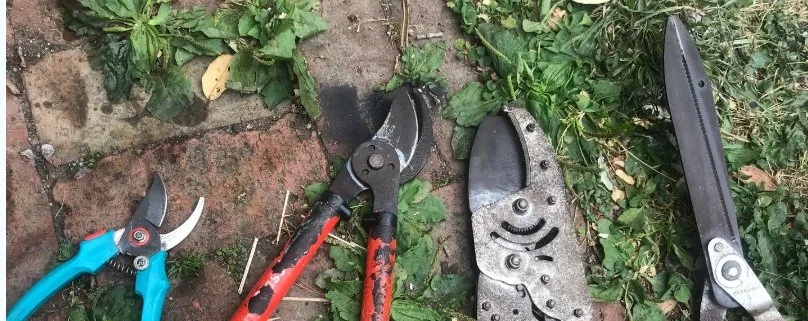Tool sharpening and storage
We had a fun one this week- someone came by to drop off some tools for sharpening and de-rusting- and they pointed out that there was no way for them to *responsibly* store gardening tools. Their garage: damp. Their shed: damp. Their garden: where most of their tools are accidentally left anyway.
We sharpen tools! We are still setting up the page on the website, but have been doing it informally since the start of the year. Get in touch if your tools need some TLC
I fully appreciate the situation. I remember, years ago, a flatmate found an old reel mower in our rented flat. It looked like a giant heap of crap to me! All rust. Those things are hard to work brand new, let alone having been left in the garden for a decade.
He pulled it apart, and I was surprised to see that the entire thing was still perfectly functional. The rust sloughed off with some wire wool, the nuts and bolts and cogs and sprockets all happy as can be. I discovered reel mowers can be gently pulled apart and a few parts reversed. Then, now that the reel spins in the opposite direction… the mower sharpens itself just by being pushed. And I was hooked.
The reel mower went back into the garden. It had nowhere else to live. We left it there, to rust again, a few months later when we moved. Sorry, mower!
When there is a lot of rust, it almost doesn’t matter how you remove it. There’s so much that any sort of scrubbing/scraping will do. It isn’t until most of it is removed that you have to be concerned about technique.. I prefer hot soapy water and any sort of wire wool
So, back to storage. Most of our tools live on the utes. We don’t bother with trying to keep them dry or even particularly clean. What we do ensure, though, is that we let a lot of air circulate when we can, and we spray them with CRC (if wet) and lithium on all of the mechanical parts (occasionally, when dry).
Because they’re used all the time, they are cleaned when too dirty or if they’ve been used for pruning plants which are susceptible to infection (or are infected themselves). You can use all sorts for this. We use apple vinegar, because it is so cheap and fantastic-
A bunch of apple cores, making sure there is still some peel on the tops and bottoms, submerged in a bucket (I use a couple of clean rocks), covered with a tea towel. Any mould that forms on top can be skimmed off. It takes about 5 weeks for the vinegar to be particularly strong, and about a week for my household to accumulate enough apple cores, I just chuck them in as they turn up. Strain and keep in a bottle. You can use this to make a consumable Apple Cider Vinegar substitute- just make sure you are substantially more hygenic and clean compared to this method!
We just wipe down blades with apple vinegar, and at the end of the day ensure tools are CRC’ed, as the vinegar can start to damage the metal (I think. I don’t think it’s a great idea to leave anything corrosive on metal!)
Halfway through rust removal on these suuuper old shears.
The other extremely handy tip with regards to any blade, is to scrape off any built up plant matter. It sticks and builds on secateurs, loppers, shears. It makes the tools slower to use and less accurate in the cut. I use an old BBQ or paint scraper for this, but you can use any blunt flat thing.
If you keep your tools well oiled, the place you store them will matter less. All of my larger tools- spades, hoes, even metal stakes- are in a big old bucket filled with old engine oil and (washed, ie not salty) sand- and kept under the eaves of the house. The sand is essentially a way to hold the oil in place and stop the bucket from tipping over.
The funny colour is black zinc- zinc will coat metal and stop rust from coming back. Unfortunately if your tools are particularly rusty, removing the rust without treating it with zinc means they will rust again quite quickly!
Sharpening itself can take as long or as short as you like, depending on what you have available. A wetstone, once purchased, will last you a very long time- mine is in constant use, and has lasted 7 years- a file will last much less time.
Start with the file, move to the wetstone, test, test, test. There are so many online tutorials on sharpening that I won’t bore you here!
We finish up with a coating of zinc, if the tools have had rust removed.
Alex is in the final throes of her apprenticeship and taught Jesse how to sharpen tools this week. It is nice to take a break from it- I have been sharpening the hedge trimmers almost weekly since November, and there are so many blades on them!
I hope you have a think about your tools this weekend, and give them some love. If anything, give them a little spray of CRC!



